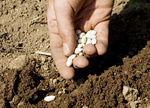Gardening tips for April: Thin seedlings
Most people sow more seeds than necessary, so proper thinning is always important and now is the perfect time to do it


The sowing of seeds is such a ritual that most people sow far more than they could ever need, and much too thickly. It would be better to take your time sowing thinly and singly. Even so, thinning will be required once the seeds have germinated and got going. Work carefully backwards along a row, patiently removing excess seedlings until those remaining are a couple of inches apart, then repeat the exercise a week or two later to leave the plants at their final spacings. Your reward will become apparent in time, and the thinnings, when from edible species, may form a delicate garnish.
* Subscribe to Country Life and save £40%
Exquisite houses, the beauty of Nature, and how to get the most from your life, straight to your inbox.
Country Life is unlike any other magazine: the only glossy weekly on the newsstand and the only magazine that has been guest-edited by His Majesty The King not once, but twice. It is a celebration of modern rural life and all its diverse joys and pleasures — that was first published in Queen Victoria's Diamond Jubilee year. Our eclectic mixture of witty and informative content — from the most up-to-date property news and commentary and a coveted glimpse inside some of the UK's best houses and gardens, to gardening, the arts and interior design, written by experts in their field — still cannot be found in print or online, anywhere else.
